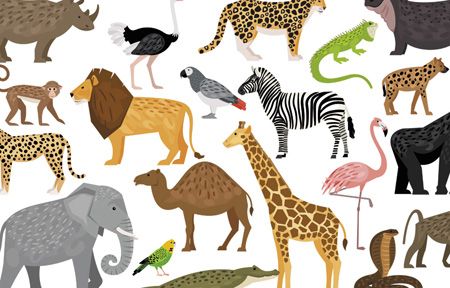Mind Over Miller: Lions, cobras and elephants-oh my!
Don't shrink from treating exotics. Dr. Robert Miller assures you that you got this.

These aren't quite the exotic patients you'll likely be seeing in your practice, but you may fear exotics nonetheless. There's no need to, says Dr. Miller. (Shutterstock)Reading the JAVMA “Veterinarians wanted” classifieds section, I am pleased to see the great number of ads that include “exotics.” [Yes, at 90 years of age, I still look at every page of my professional journals.]
I was trained in six domestic species. During my four years in veterinary school, only once did I see an exotic species-when a pet mountain lion was shown to us during rounds with what I later discovered to be an incorrect diagnosis-osteogenesis imperfecta, a congenital disease.
I learned a few years later that what that cat actually had was secondary nutritional hyperparathyroidism caused by an all muscle meat diet, which is calcium-deficient. I learned that is was epidemic in captive exotic feline species.
How did I learn?
I established a practice in Thousand Oaks, California, the main town in Ventura County's Conejo Valley, with a population of 1,250 people.
Why?
Despite its low human population, the Conejo Valley had an enormous animal population. This included many horse ranches and cattle ranches that used horses. I wanted to be sure that my mixed practice included horses.
The area had never had a local veterinary practitioner. All veterinary services came in from adjacent Los Angeles County or more populous western Ventura County.
Although this area today is suburbanized and is the home for many high-tech firms, back then the only industry in the valley was the wild animal industry, mainly used to supply Hollywood's movie and TV businesses with any kind of exotic species they required. Unlike adjacent L.A. County, our county had very lenient zoning restrictions.
We had Jungleland, a huge zoo that included more than 100 big cats-lions, tigers, leopards, etc. Most of these were well-trained and, unbelievably today, were kept mostly in small cages and, if gentle enough, were walked in our main street for exercise and chained to the oak trees that lined the boulevard.
There was an elephant training center, a camel breeding farm, the headquarters for the Big John Strong Circus, Bird Wonderland, a snake and lynx farm with every conceivable species, and many, many people who just kept one or two animals for the infrequent but profitable requests from show business for their special animals.
The Clark family, for example, had a mature African male lion who shared their bedroom. Even more unusual, they had a large glass aquarium next to their bed that contained a full-sized spitting cobra.
I loved the variety and the challenges my practice provided. For a couple of years, I telephoned the veterinarians in leading zoos all over the world. Gradually, I realized that it was the blind leading the blind.
My boyhood hero was the African explorer, wildlife expert, taxidermist and adventurer Carl Akeley. I read and reread his books many times and any other wildlife books I could find in the library.
With that background combined with my medical schooling and, above all, reverence for evolution and natural selection, I was able to do a good job for my exotic animal clients and developed a love and respect for wildlife medicine that enhanced my ability to treat domestic species.
I convinced many of my clients that carnivorous animals don't eat meat. They eat other animals, including bone and blood, which are rich in calcium. “Meat” is not!
I preached that chimpanzees should not be fed a diet limited to fruits and vegetables. I added foods of animal origin (egg, meat, a little cheese) and they thrived. Their teeth told me that they were omnivorous and not strictly vegetarian-a fact confirmed decades later by Jane Goodall, the renowned chimp scientist.
The point I'm trying to make to my colleagues is this: Don't shy away from exotic species patients simply because of a lack of familiarity or because you had no exposure to the species in school. Accept the challenge. Combine common sense with your medical training.
Today a huge wealth of data is available that was unimaginable during my early practice decades. Modern communication methods easily link us today with colleagues and other scientifically trained individuals. The information is out there.
For those of us who are passionate about our profession, exotic animal practice can be both challenging and tremendously satisfying.
I never planned on such a practice before I graduated, but I have been so glad I discovered it. Most important, it greatly enhanced my understanding of domestic animal medicine. It made me a better doctor of veterinary medicine.
Robert M. Miller, DVM, is an author and a cartoonist and speaker from Thousand Oaks, California. His thoughts in "Mind Over Miller" are drawn from 32 years as a mixed-animal practitioner. Visit his website at www.robertmmiller.com.
Your chance to meet and learn from Dr. Miller fast approaches! Don't miss his equine medicine sessions at CVC Kansas City, Aug. 25-28.